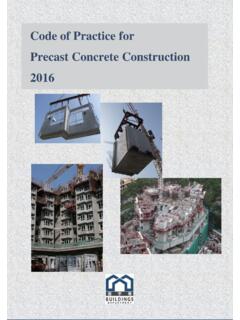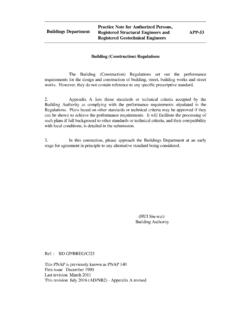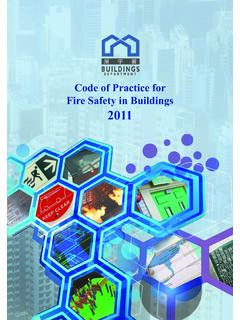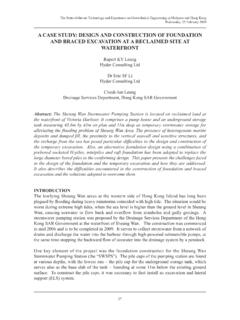Transcription of Practice Note for Authorized Persons, Registered ...
1 Buildings Department Practice Note for Authorized Persons, Registered Structural Engineers and Registered Geotechnical Engineers APP-57 Requirements for an Excavation and Lateral Support Plan Building (Administration) Regulation 8(1)(bc) Introduction Bulk excavation, even if shallow, can be dangerous if not properly designed. Authorized persons, Registered structural engineers (RSE) and Registered geotechnical engineers (RGE) are reminded to take adequate precautions to ensure public safety whenever excavation is found necessary as part of the work. Reference shall be made to PNAP APP-18 and PNAP APP-137 on details of monitoring requirements if piling and similar operations are included.
2 Criteria for Submission of Excavation and Lateral Support Plans 2. In general terms, excavation and lateral support (ELS) plans are required under Building (Administration) Regulation 8(1)(bc) to be submitted for approval where excavations of substantial depth are to be carried out, the collapse of which would cause serious consequences. 3. ELS plans will be required to be submitted to the Buildings Department (BD) for approval where the excavation works to be carried out are: (a) deeper than m and greater than 5 m in length; and (b) liable to affect any road, building, structure, slope steeper than 30 or water main 75 mm in diameter or greater, the affected area being defined as within the 45 line up from the base of the excavation to the ground surface.
3 4. Where the above conditions apply, consent to commence ELS works would not be given if ELS plans, as prescribed in Building (Administration) Regulation 8(1)(bc), have not been submitted and approved. 5. Where ELS plans are required to be submitted for approval as stipulated above, an RSE would be required to prepare and sign the plans and structural design as well as the structural assessment report of the effects of the excavation and dewatering on adjoining structures. For ELS plans with excavation depth deeper than , an RGE would be required to prepare and sign the supporting documentations, such as geotechnical assessment, geotechnical details and calculations, geotechnical reports, site investigation reports or ground investigation reports, which should accompany the ELS plans submission.
4 /6.. - 2 - 6. It is permissible to have the ELS plans submitted in two stages, provided that the first stage submission demonstrates the feasibility of the entire scheme. Plans submitted at the first stage should show the lateral support system, for example sheet piles or a diaphragm wall, together with a strutting layout and the construction sequence. The supporting geotechnical documentation should also be provided. Calculations submitted at the first stage should include realistic ground movement estimates for the entire works. The second stage submission normally would include the structural details of the lateral support system, including detailing of the struts for each stage of excavation according to the approved first stage submission.
5 Global Safety Factor Method 7. The global safety factor method has generally been used in the design of ELS works. In this method, unfactored soil strength parameters and loads are used in the stability checks for compliance with Building (Construction) Regulation 15. Limit State Partial Factor Method 8. With the publication of Report No. C580 by the Construction Industry Research and Information Association of the United Kingdom (CIRIA Report No. C580) in 2003, a Limit State Partial Factor (LSPF) method for embedded retaining walls was introduced. In this method, soil structure interaction analysis is carried out for both the serviceability limit state (SLS) and ultimate limit state (ULS) conditions.
6 Soil parameters and loads shall be applied with partial factors in the design of ELS works. A review conducted by the BD, the Geotechnical Engineering Office of the Civil Engineering and Development Department and the industry in 2011 concluded that the LSPF method could be used as an alternative to the global safety factor method. This alternative method shall conform to the guidance and requirements given in the "Notes on design of Excavation and Lateral Support Works" at Appendix A. Submission Requirements 9. In all ELS plans submissions, the design method used should be stated on the plans and calculations. The submission procedures for the LSPF method for ELS works will be the same as that for the global safety factor method.
7 However, ELS works design based on a mixture of both methods are not allowed. 10. Computer programs to be used to support the design proposals should be submitted to the BD for prior acceptance. The general requirements for prior acceptance of computer programs are given in PNAP ADM-6. Even if a computer program is applicable to both design methods, separate application for prior acceptance of the computer program for each design method is required. ( AU Choi-kai ) Building Authority - 3 - Ref. : BD GP/BREG/C/14 This PNAP is previously known as PNAP 148 First issue October 1991 Last revision August 2011 This revision February 2012 (AD/NB2) (Paras.)
8 1, 3 & 5 amended) Appendix A (PNAP APP-57) Notes on design of Excavation and Lateral Support Works 1. Introduction This document provides technical guidance and requirements for the design of excavation and lateral support (ELS) works in hong kong . Those given in Section 2 are general guidance and requirements for ELS works, which are currently adopted in the global safety factor method and are also applicable to the Limit State Partial Factor (LSPF) method. Those given in Section 3 are applicable to the LSPF method only and these include the modifications to the CIRIA Report No. C580 to suit local design standards and Practice .
9 2. General Guidance and Requirements (APPLICABLE TO BOTH GLOBAL SAFETY FACTOR METHOD AND LSPF METHOD) Serviceability Limit State (SLS) Checks Where necessary, SLS checks should be carried out to assess the impacts on adjoining buildings, structures, services and land. For the assessment of ground movement and lateral wall movement caused by retaining wall installation, dewatering and excavation, the guidance given in GCO Publication No. 1/90 could be used. Soil Stiffness In applying correlations between soil stiffness and SPT N values from reliable published case histories, account should be taken of the soil type and the computer program used in the back analyses for deriving the correlation.
10 Hydraulic Failure The guidance given in Section of GCO Publication No. 1/90 should be followed and a minimum factor of safety of should be used to guard against hydraulic failure. In the design , account should be taken of the uncertainties in ground conditions ( soil layering and heterogeneity in permeability) and the uncertainties in the application of the design charts in the particular site conditions. design Report and design Review The design report should be certified by the RSE and RGE. It should state that: (a) the analyses demonstrate that there is an adequate safety margin against collapse of the excavation, and (b) there will be no unacceptable impacts due to the ELS works provided that the design assumptions are verified and found to be valid and the works are being carried out as specified during construction.











